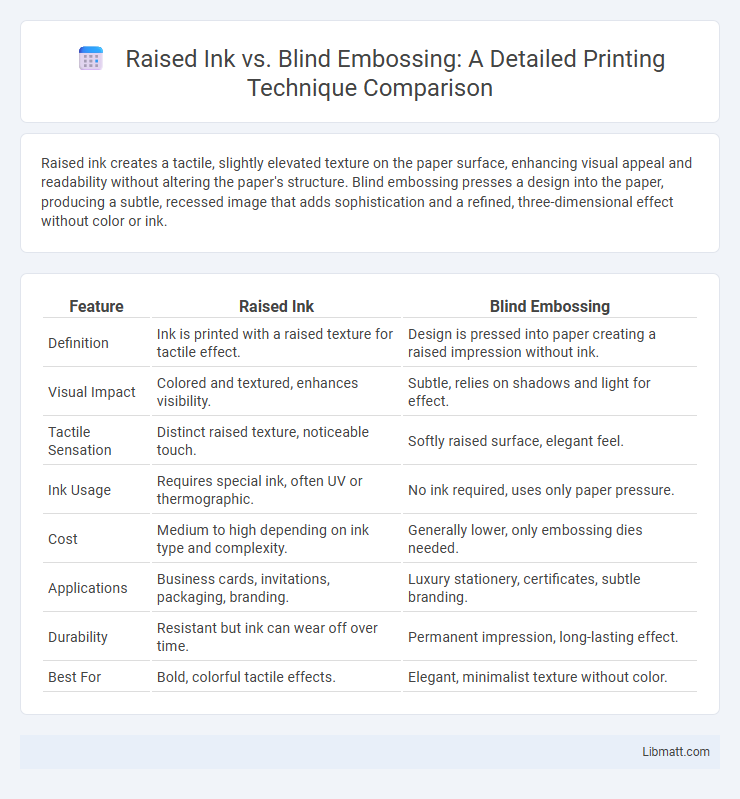Raised ink creates a tactile, slightly elevated texture on the paper surface, enhancing visual appeal and readability without altering the paper's structure. Blind embossing presses a design into the paper, producing a subtle, recessed image that adds sophistication and a refined, three-dimensional effect without color or ink.
Table of Comparison
| Feature | Raised Ink | Blind Embossing |
|---|---|---|
| Definition | Ink is printed with a raised texture for tactile effect. | Design is pressed into paper creating a raised impression without ink. |
| Visual Impact | Colored and textured, enhances visibility. | Subtle, relies on shadows and light for effect. |
| Tactile Sensation | Distinct raised texture, noticeable touch. | Softly raised surface, elegant feel. |
| Ink Usage | Requires special ink, often UV or thermographic. | No ink required, uses only paper pressure. |
| Cost | Medium to high depending on ink type and complexity. | Generally lower, only embossing dies needed. |
| Applications | Business cards, invitations, packaging, branding. | Luxury stationery, certificates, subtle branding. |
| Durability | Resistant but ink can wear off over time. | Permanent impression, long-lasting effect. |
| Best For | Bold, colorful tactile effects. | Elegant, minimalist texture without color. |
Introduction to Raised Ink and Blind Embossing
Raised ink, also known as thermographic printing, creates a tactile, glossy texture by heating powdered resin on printed areas, enhancing visual appeal and readability. Blind embossing involves pressing a design into the paper without ink or foil, producing a subtle, raised impression that adds elegance and sophistication. Your choice between these techniques depends on the desired texture, visual impact, and printing method for your project.
What Is Raised Ink Printing?
Raised ink printing is a tactile printing technique that creates a three-dimensional effect by applying a thick layer of ink onto paper, resulting in a textured surface you can feel. This process uses specialized inks and printing presses to build up ink layers, providing a distinctive look and enhancing the visual and sensory experience of printed materials. Unlike blind embossing, which relies on pressing designs into the paper without ink, raised ink printing adds both texture and color for a bold and dynamic finish.
Understanding the Blind Embossing Technique
Blind embossing is a printing technique that creates a raised or recessed design on paper without using ink, relying solely on pressure to form the impression. This method enhances texture and adds a subtle, elegant dimension to business cards, invitations, and stationery, making the design visually distinctive through shadows and depth. Unlike raised ink, blind embossing produces a tactile effect without any color contrast, offering a sophisticated, understated aesthetic.
Visual Appeal: Raised Ink vs Blind Embossing
Raised ink creates a tactile and visually striking effect by adding color and depth to the design, making images and text stand out vividly on the surface. Blind embossing offers a subtle, elegant appearance through raised impressions without ink, providing a sophisticated texture that relies solely on light and shadow for visual appeal. Your choice between the two techniques will depend on whether you prefer bold, colorful highlights or understated, classic refinement.
Tactile Experience and Texture Differences
Raised ink creates a textured, tactile surface by applying layers of ink that physically rise above the paper, offering a pronounced feel under your fingertips. Blind embossing presses an image or design into the paper without ink, producing a subtle, recessed texture that is smooth yet discernible through touch. Your choice between raised ink and blind embossing affects not only the visual appeal but also the sensory interaction with printed materials.
Durability and Longevity of Both Methods
Raised ink offers high durability due to its thick application, resisting wear and maintaining texture over time, making it ideal for frequently handled items. Blind embossing, while elegant and subtle, tends to be less durable as it relies on pressed impressions that can flatten or fade with repeated use. Both techniques provide a premium tactile experience, but raised ink outperforms blind embossing in longevity and sustained visual impact.
Customization Options: Flexibility and Limitations
Raised ink offers extensive customization options, including a variety of colors, textures, and thickness levels that enhance tactile appeal and brand identity. Blind embossing provides a more subtle, elegant effect with limited customization, primarily focusing on depth and shape without color variation. While raised ink allows more creative flexibility, blind embossing excels in understated sophistication suited for premium designs.
Cost Comparison: Raised Ink vs Blind Embossing
Raised ink printing generally incurs higher costs compared to blind embossing due to the specialized inks and precision equipment required for tactile effects. Blind embossing is more cost-effective as it utilizes a simple die-stamping process without additional ink or color, reducing material and production expenses. Businesses often choose blind embossing for budget-conscious projects while selecting raised ink when enhancing brand visibility and texture justifies the premium price.
Best Applications for Each Printing Method
Raised ink is ideal for tactile elements such as business cards, invitations, and packaging where a textured, three-dimensional effect enhances visual appeal and sensory experience. Blind embossing works best for elegant branding on stationery, book covers, and luxury packaging by creating subtle, raised impressions without the use of ink or color. Both methods are favored for premium print materials, with raised ink providing more visual prominence and blind embossing offering sophisticated minimalism.
Choosing the Right Technique for Your Project
Raised ink provides a tactile, glossy finish ideal for logos and decorative elements requiring high visibility, while blind embossing offers a subtle, elegant impression without color or ink. Selecting the right technique depends on your project's need for visual impact versus understated sophistication, as well as the type of paper and budget constraints. For branding materials, raised ink enhances brand recognition through texture and shine, whereas blind embossing is suited for luxury invitations or stationery seeking a refined, classic look.
Raised Ink vs Blind Embossing Infographic

 libmatt.com
libmatt.com